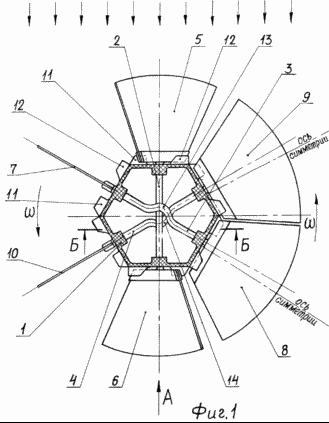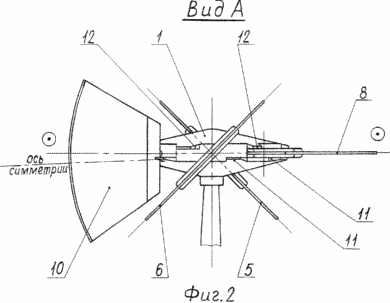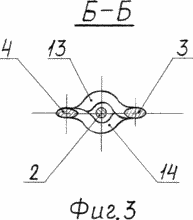| Start of section
Production, amateur Radio amateurs Aircraft model, rocket-model Useful, entertaining |
Stealth Master
Electronics Physics Technologies Inventions |
Secrets of the cosmos
Secrets of the Earth Secrets of the Ocean Tricks Map of section |
|
| Use of the site materials is allowed subject to the link (for websites - hyperlinks) | |||
Navigation: => |
Home / Patent catalog / Catalog section / Back / |
|
INVENTION
Patent of the Russian Federation RU2289722
![]()
Wind turbine (Wind turbine)
The name of the inventor: Shmakov Yuri Mikhailovich
The name of the patent holder: Shmakov Yuri Mikhailovich
Address for correspondence: 426004, Izhevsk, ul. Udmurt, 159, ap. 230, Yu.M. Shmakov
Date of commencement of the patent: 2005.01.31
Wind turbine is designed to convert wind energy into mechanical energy. The windmill consists of a hub, two pairs of rotary blades connected by shafts located in one plane, one of which is straight, and the other has a central bend located above the straight shaft; co-axial blades are made with centers of gravity displaced relative to the axis of their rotation, In the working position by turning. The blades are installed mutually perpendicularly with the possibility of contact with the stops placed on the hub. In addition, the windmill is equipped with two additional perpendicularly located blades connected by a shaft made with a central knee located under a straight shaft. The blades are sector-shaped and installed in such a way that their lateral edges, when the blades are in the horizontal plane, adjoin each other with a minimum clearance. Each blade is fixed in a horizontal position by contacting the base of the blade with the upper and lower stops spaced from the shaft axis located on the hub. The design ensures efficiency by increasing power and uniformity of rotation.
DESCRIPTION OF THE INVENTION
The invention relates to wind power plants.
A rowing wheel is known, consisting of a hub and several pairs of coaxial radially located shafts with blades and turning mechanisms (see IA Luchanskii, AA Yanovskii, "From the Oars to the Water Jet," Moscow: Shipbuilding, 1964, p.63). This invention was adopted as a prototype. Its shortcomings include:
1. The presence of rotation mechanisms determines the smooth change in the position of the blades and the presence of one blade in the maximally deployed position against the flow at the moment of being in the lowest position, and the other coaxial blade maximally located upstream in the highest position, in all other positions all the blades are under Some angle to the flow, which reduces the total useful force of the lower blades and increases the total resistance to rotation of the upper blades.
2. The presence of separate short coaxial shafts increases the load on the bearings, frictional force and wear.
3. The presence of special mechanisms for turning the blades complicates the design, reduces the longevity of its operation.
4. With the rotation of a part of the blades against the wind, narrow blades with uniform rotation mechanisms do not ensure their overall horizontal position, create great drag and vertical loads, which reduces the efficiency of the design.
The aim of the invention is to increase the efficiency of the wind turbine. To this end, a windmill consisting of a hub, two pairs of rotary blades connected by shafts arranged in one plane, one straight shaft, another shaft having a central bend located above the straight shaft, co-axial blades are made with centers of gravity offset from the axis of their rotation with Ensuring the self-alignment of the blades in the working position by turning and installed mutually perpendicularly with the possibility of contact with the stops placed on the hub, is provided with two additional perpendicularly positioned blades connected by a shaft made with a central knee located under a straight shaft; the blades are sectored and thus mounted , That their lateral edges, when the blades are in the horizontal plane, adjoin each other with a minimum gap. In addition, each blade is fixed in a horizontal position by contacting the base of the blade with the upper and lower stops spaced from the shaft axis located on the hub.
The essence of the invention is explained by the drawings.
 |
 |
 |
1 shows a wind turbine from above, without an upper part. FIG. 2 shows a view A of FIG. 1. FIG. FIG. 3 is a sectional view of the shafts BB in FIG. 1. FIG. |
The windmill consists of a hub 1 and three radially arranged rollers 2, 3, 4 with mutually perpendicular blades 5 and 6, 7 and 8, 9 and 10. The axis of symmetry of each blade is offset relative to the axis of its rotation. On the outer surface of the hub 1, the stops 11 and 12 are installed cooperating with the bases of the blades 5, 6, 7, 8, 9, 10 in the horizontal position. The shaft 2 is straight, the shafts 3, 4 have central bends 13, 14 located above and below the straight shaft 2.
WINDROWER WORKS AS FOLLOWING
In the presence of wind, the blades 5-10 themselves are installed on one side of the windmill in the wind - vertically, and on the other side of the windmill against the wind - horizontally. The change in the position of the blades 5 and 6, 7 and 8, 9 and 10 occurs when the axis of the shaft 2, 3 or 4 coincides with the direction of the wind.
In the absence of wind, all blades 5-10 are exposed to the equilibrium position - at an angle of -45 ° to the vertical (like the blades 5, 6 in Figures 1, 2) and are in this position until the wind appears. Blades 5, 6 on shaft 2, whose axis coincides with the direction of the wind, are not affected by the wind and, due to the arrangement of the center of gravity of the blades 5, 6 below the pivot axis and from opposite sides of the vertical plane passing through the shaft axis 2, ~45 ° to the vertical. When the wind turbine rotates at a small angle between the axis of the shaft 2 and the direction of the wind, due to the downward displacement and pressure centers of the blades 5, 6 relative to the pivot axis (axis of the shaft 2), a joint wind force acts on the blades 5, 6, tending to turn the shaft 2 in one direction , While one blade is installed vertically and moves in the wind, while the other, displaced by 90 °, is installed horizontally and moves against the wind. On one side of the windmill, several blades are exposed in a vertical position, most often three, moving in the wind, on the other side of the windmill in the horizontal direction - opposite three blades, moving against the wind. Vertical, far from each other located blades create greater sail, a large uniform power stop, and horizontal blades, installed with a small gap, provide minimal resistance when moving them against the wind.
Hub 1 has a lenticular, hexagonal in plan shape with upper and lower stops 11, 12 on each face. This shape provides a minimum shading of the blades 5-10 and a maximum spacing of the stops 11, 12 from the axes of the shafts 2, 3, 4.
Blades 5, 6, 7, 8, 9, 10 have a sectoral shape with minimum gaps between sectors with the horizontal position of adjacent blades (FIG. 1). When moving them against the wind, the minimum resistance to movement is ensured. The diameter of the wind wheel is fully used. Short blades 5, 6, 7, 8, 9, 10 provide a small difference in speeds at the bases and vertices of the blades 5-10, which reduces noise during operation and increases the possible speed of rotation. The moment of inertia increases, which increases the uniformity of rotation. A large area of the end part of the blades contributes to its greater bending under the influence of wind. With a normal wind, this increases the uniformity of the force action on the blades 5-10 and increases the uniformity of rotation, and in strong winds protects the blades 5-10 and the windmill from overloads. Blades 5-10 are made of stainless steel, bronze or plastic of one or variable thickness. The flexibility of the blades 5-10 during operation prevents their icing.
All the shafts 2, 3, 4 lie in one plane and their axes intersect at one point. The shaft 2 is straight, and the shafts 3, 4 - with the central bends 13, 14. This solution allows all shafts 2, 3, 4 to be completely solid, with the most spaced support, to reduce the load on the bearings and wear parts, to make the hub 1 split bearing , Which simplifies the manufacture, assembly and repair of the wind turbine. Fixation of blades 5-10 in the horizontal direction is carried out by two maximally spaced stops 11, 12 (with elastic inserts - not shown). This reduces the impact force and noise when the blades 5-10 contact with the stops 11, 12. Increasing the power of the windmill is possible by increasing the diameter and using more shafts (4, 5, 6) and blades (8, 10, 12). The central knee of additional shafts should be larger. In this case, the horizontal dimensions of the hub 1 are increased, and solar batteries can be installed on the top of it.
In the absence of wind, all blades 5-10, due to the displacement of their centers of gravity relative to the axis of rotation, are set at an intermediate, starting position - at an angle of ~45 ° to the vertical. When a wind appears, it acts on the plane of most of the blades, which, due to the displacement of the pressure centers below the axis of rotation, are rotated and set to the working position. Rotation of the wind turbine is possible even at a low wind speed, which increases the running time of the windmill.
Due to the large number of blades vertically moving along the wind and the horizontal arrangement of opposite blades moving against the wind, an increase in the power and uniformity of rotation of the windmill is achieved. The design is not afraid of overload and icing, simple, durable and aesthetic. It is possible to install it separately on the stand, or on the house, easily made detachable, convenient for transportation and installation. All this increases the efficiency of the windmill. The author made an experienced four-bladed wind turbine. The largest transverse dimension is 206 mm, the hub diameter is 44 mm, the blades are rectangular 80 × 40. The windmill starts to rotate from the indoor fan.
The invention can also be used for mini hydroelectric power stations, while the rotor axis can be positioned vertically, horizontally or at an angle to the horizon, depending on local operating conditions.
The invention can also be used as a propeller for a ship. With the horizontal position of the rotor axis in the water flow, it is possible to immerse a part of the wheel (less than half).
CLAIM
1. A wind turbine consisting of a hub, two pairs of rotary blades connected by shafts arranged in one plane, one straight shaft, another shaft having a central bend located above a straight shaft, co-axial blades are made with centers of gravity offset with respect to the axis of rotation thereof, Self-alignment of the blades into the working position by turning and installed mutually perpendicularly with the possibility of contact with the stops placed on the hub, characterized in that it is provided with two additional perpendicularly positioned blades connected by a shaft formed with a central knee located under a straight shaft; the blades have a sectoral shape And are installed in such a way that their lateral edges, when the blades are in the horizontal plane, adjoin each other with a minimum clearance.
2. The wind turbine according to claim 1, characterized in that each blade is fixed in a horizontal position by contacting the blade base with the upper and lower stops spaced from the shaft axis.
print version
Publication date 31.01.2007gg




Comments
Commenting on, remember that the content and tone of your message can hurt the feelings of real people, show respect and tolerance to your interlocutors even if you do not share their opinion, your behavior in the conditions of freedom of expression and anonymity provided by the Internet, changes Not only virtual, but also the real world. All comments are hidden from the index, spam is controlled.